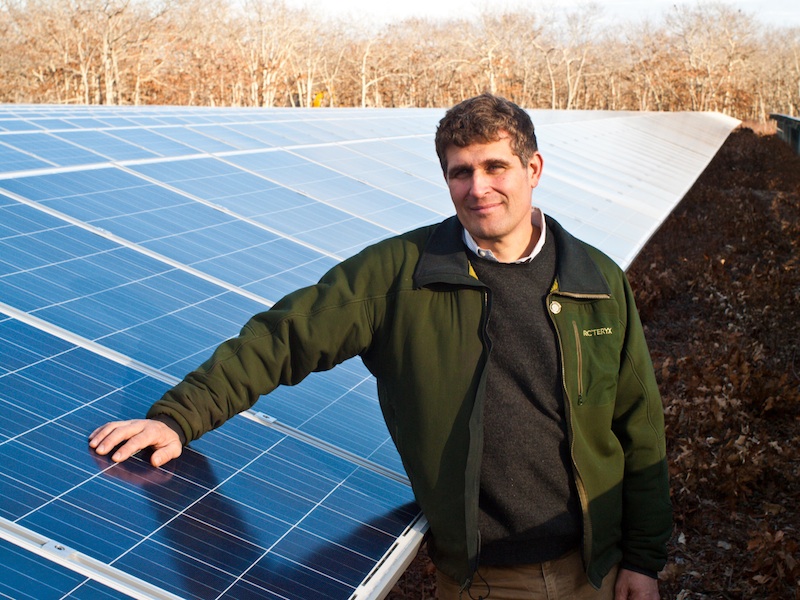A soft buzz of 250,000 watts of energy echoed off of Watcha Path in Edgartown on Thursday afternoon.
“Listen to that hum,” Bill Bennett told a group of Martha’s Vineyard Public Charter School students standing next to several transformers at Mr. Bennett’s new solar array.
The hum Mr. Bennett spoke of was that of energy being produced by 2,500 new photovoltaic panels. The panels are powering some, if not all, of the electricity used by the YMCA of Martha’s Vineyard, the Edgartown National Bank, the Tisbury Farm Market and Vineyard Grocer in Vineyard Haven, and the Martha’s Vineyard Public Charter School. Representatives from each of the organizations and several charter school students were on site Thursday afternoon to flip a ceremonial switch.
With the new energy supply, the charter school is the first public school in the state to rely completely on green energy as a source for power.

Work on the solar array began last November and came onto the grid a month ago.
Mr. Bennett, a contractor, is selling the electricity to the YMCA and the charter school at a discounted price.
Standing among the panels, Mr. Bennett explained the purchase and sale process, done through a series of utility credits from NStar, the region’s electricity supplier.
“NStar buys my power through utility credits . . . each of which is worth a dollar,” he said. “You have the utility credits and you can transfer them to whoever has an NStar account. If I have 100 utility credits and I transfer them to, say, the YMCA, they’ll get a discount and they’ll send me back a little less than $100.”
“They’re going to save money on their NStar bills in a way that’s not possible in any other fashion,” he added. “It allows them the freedom to buy the lowest priced electricity . . . they’re not buying power from me; they’re just monetizing my credits.”
Several other organizations have also signed on to purchase energy from Mr. Bennett. Credits for the Watcha Path location are still available.
The site of the arrays was originally slated to be the site of the Cozy Hearth affordable housing development. Mr. Bennett and several other Vineyard residents proposed building homes for themselves along with affordable houses. The plan went through a multi-year review process through town boards, the Martha’s Vineyard Commission and several appeals courts before it was eventually scrapped.
Mr. Bennett expressed his enthusiasm in the change of course for the land. The charter school students were part of the building process from the beginning. Mr. Bennett visited the students in their classroom, and in turn the students visited the site to help install some of the panels.
“We did a bunch of classes about the physics and mechanics of solar power, but also about the economics of solar power,” Mr. Bennett said. “It was great to teach the kids how incentives work and see them get it.”
Charter school development director Paul Karasik said using electricity from the Watcha Path array was a natural fit.
“Bill is a former charter school parent and a huge supporter from the start of the mission of the charter school, particularly the hands-on experiential learning,” he said. “When he got this idea, in part it was to have the students come out and experience the installation.”
The panels will last 30 years, Mr. Bennett said, at which point they’ll continue to produce at 80 per cent of their initial capacity.
Mr. Bennett stressed the Vineyard connection.
“These are made locally and used locally,” he said. “One of the things I talk about is that half of the power generated from the United States gets lost in transmission between the power plant and the house. When you make power locally you lose much less percentage in transmission.”
Mr. Bennett is also leasing land from Whippoorwill Farm owner Andrew Woodruff at the farm’s Old County Road location for another 250,000 watt array. Mr. Bennett said members of Whippoorwill Farm’s community-supported agricultural program could purchase solar credits from the array in the future. Mr. Woodruff is calling it community-supported power, he said.






Comments (2)
Comments
Comment policy »